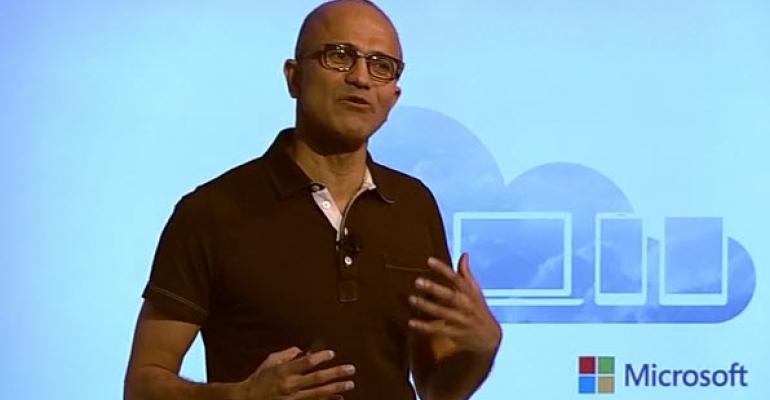Celebrating day 52 as the CEO of Microsoft, Satya Nadella took the webcast stage to kick-off his first public press announcement event.
During the first few minutes, Satya outlined a strategy that has been several years in the making, and one that we've heard over and over. Microsoft's intent is to bring enable "A cloud for everyone, on every device." Doing that requires Microsoft to address three pillars of outreach success, bringing together value for end-users, developers, and IT Professionals.

Satya talked through his vision of a future where the entire landscape of computing is digitized across a multitude of devices, including PCs, tablets, and other devices. Exponential growth of users, applications, and devices in the Cloud means that his originally stated prophecy of Mobile First, Cloud First is spot on, and that Microsoft needs to be ready to support new form factors that will be birthed along the way. Satya put it as: "ubiquitous computing and ambient intelligence."

After a brief introduction, Satya gave the stage over to Julia White, who was on hand to provide demos for the major product release announcements.
Office for the iPad
The first demo and announcement was on the official release of Office for iPad, a touch-enabled, beautiful touch experience for Apple's popular tablet.
Released today at 11am PST in Apple's iTunes store, Office for iPad is provided for free. Word and Excel include in-app purchase capability, which is required if users want to do more than just view applications. A full Office 365 subscription is necessary to edit and create Microsoft Office files. In essence, the freely downloadable apps today are just a better "viewer" than has been previously available on the iPad. Fully-enabled (subscribed) apps ensures that all expected Office application features are available, including markup and collaboration.

In addition, to the expected features, Microsoft has also developed some iPad-specific features, in particular PowerPoint includes a touch-and-hold function that enables a laser pointer for presentations.
The intent for the future is to bring touch-enabled Office to all devices and platforms (web, tablets, smartphones, PCs, etc.). OneDrive is the conduit that will be used to connect all platforms.
Touch offerings for additional platforms (hint: Android and Windows 8.1) will be announced at a later date, with the intent to bring "Office 365 everywhere."

Our own Paul Thurrott has already written up some great coverage on Office for iPad.
Enterprise Mobility Suite (EMS)
As I talked about in more detail yesterday in Preparing for System Center Configuration Manager in the Cloud, Microsoft also announced the new Enterprise Mobility Suite (EMS), which is a bundling of Windows Intune with Microsoft Azure Active Directory Premium and Azure Rights Management Services.
Julia White also provided the demo services for this announcement, showing the Windows Intune application and device portals running on a Samsung Android tablet. During the demo, Julia showcased how end-users can use self-service to install IT authorized apps, but also how to de-authorize personal devices should the need arise. The demo example highlighted an employee that wanted to detach an iPhone for the corporate network so it could be regifted to her daughter. A visit to the corporate device portal in Windows Intune allowed the employee to accomplish this quickly.

EMS is Microsoft's ever-evolving approach to BYOD and BYOA. Windows Intune combined with Azure AD and Azure Rights Management ensures a more holistic, more secure consumerized experience that reaches into the Enterprise. Azure AD and Rights Management allows IT Pros to setup two-factor authentication against AD accounts stored in the Microsoft Cloud. It also enables end-users to have single sign-on capability for any other web-based service like Box or Dropbox. Azure AD caches user credentials for the non-Microsoft web properties, but also allows IT to authorize the apps available for the end-users to utilize.

Later, Satya also noted that with EMS, Microsoft is determined to tame the complexity that has arisen due to BYOD. He also stated that EMS is the future for IT Pros and Enterprise architecture. And, this really fits with what I've been suggesting for a long while, that System Center Configuration Manager (an on-premise only product) may be on its last legs.
EMS will be available in Enterprise Volume Licensing channels starting on May 1, 2014 and Microsoft will charge enterprises on a per-user basis (not on a per-device basis).
Developer Audience
The message for developers was short, again highlighting Azure AD as a means for single authentication for newly developed apps. However, the message was clear that Microsoft believes the future of development is all based in Office 365 apps. Julia's demo was concerted on SharePoint and how Azure AD provides single sign-on capability.
I'm not sure how the developer audience feels about the limited focus during the event, however, BUILD is coming up next week and the focus there will be 100% on development.
What About Windows?
Both Satya and Julia spent an enormous amount of time on platforms other than Windows, so Satya ended the event by addressing the obvious: What about Windows?
Windows, as Satya stated, is a massive undertaking and there are definite innovations happening in OS and devices. Microsoft is absolutely committed to providing a touch-enabled Office experience that runs on Windows, however Microsoft needs to excel everywhere customers exist. Satya seemed to suggest that Windows is now an afterthought. In a highly mobile world where Android and iOS prevail, Microsoft must focus there first. Microsoft wants to move beyond a competitive reality, and instead be motivated to build experiences that extend across all platforms. Microsoft will focus on developing to reach customers where they are, whether or not they run Windows.

And, that really sums up Microsoft's new focus of a cloud for everyone, on every device. Microsoft wants to deliver the Cloud to every device through Azure and Office 365, even if, it seems, Windows fades to nothing. More important than the product release announcements today, was the declaration that Windows just doesn't matter as much anymore.






